Reputed as one of the greatest archaeological finds in the twentieth century and the eighth wonder of the world, buried at 1.5 km east of Qinshihuang’s Mausoleum, Terracotta Army or Terracotta Warriors and Horses (兵马俑) is the funerary object of Emperor Qinshihuang (259~210 BC), the first Emperor of China. In ancient China, people believed in after-world, thus, Emperor Qinshihuang built the Terracotta Warriors and Horses as his underground army to protect his soul in the after-world.
In 1979, Qin Terracotta Warriors and Horses Museum was open to the public on the excavation site. In 1987, the museum, together with the Mausoleum of the First Qin Emperor (they were combined into Emperor Qinshihuang’s Mausoleum Site Museum in 2009, the museum was selected by Trip Advisor as the top 25 museum in the world, the only Asian museum on the list) were listed as World Heritage Sites by UNESCO. After being buried in the ground for over 2,200 year, the Terracotta Army was finally accessible to public.
There is a small village called Xiyang Village and located 1.5km east to the Qinshihuang’s Mausoleum. The southern part of the village was once a persimmon forest. In March 1974, the villagers of Xiyang Village were planned to dig a well in the persimmon forest to fight the drought. During the digging, they found several wrecked terracotta figures and some bronze weapons. The Villagers stopped the digging and informed the local authority immediately. In July 1974, an archaeological team was sent to excavate the discovery site, thus, the magnificent Terracotta Warriors and Horses started to reveal its true face to the public.
The first discovered terracotta warriors pit was called Pit One. In 1976, the State Council decided to establish an exhibition hall on the Pit 1. In the construction progress, Pit 2 was found in the north of the eastern part of the Pit 1. In May of the same year, Pit 3 was found in the north of the western part of the Pit 1. Now, three Pits are all opened to the public, and you can even see the site excavation on the Pit Two.
No matter when you come to Xian, visiting the Terracotta Warriors and Horses is the No. 1 thing to do in Xian. Below are 3 recommended Xian Tour Packages including the Terracotta Warriors and Horses
- 2 Days Xian City Break
- 3 Days Classic Xian Tour
- 4 Days Xian Highlights Tour with Mount Huashan Hiking
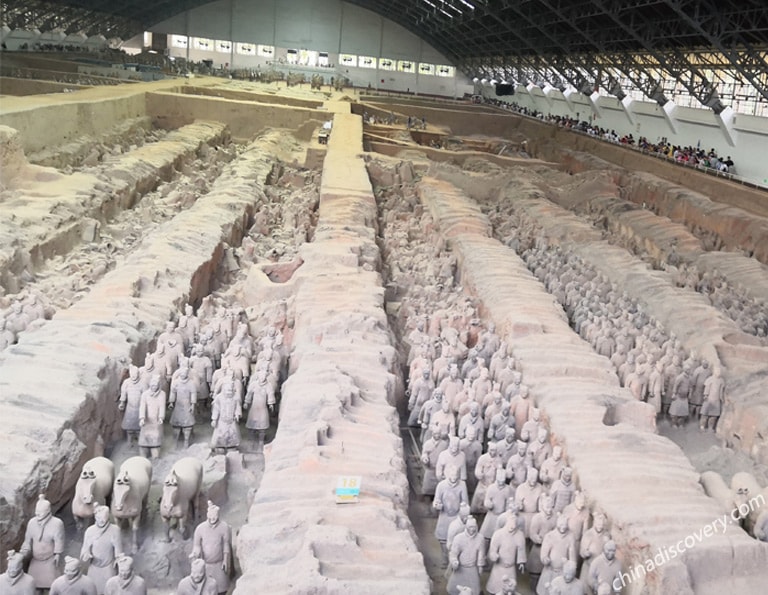 Terracotta Warriors and Horses
Terracotta Warriors and Horses
The Terracotta Warriors is situated at Qinling North Road, Litong District, Xian City, Shaanxi Province (陕西省), Northwest China which neighbors with many inland provinces including Inner Mongolia in the north, Shanxi and Henan Provinces in the east, Chongqing, Sichuan and Hubei Province in the south, Gansu and Ningxia in the west. Chinese address is: 西安市临潼区秦陵北路秦始皇兵马俑博物馆. It is about 40km from Xian downtown, about 66km from Xian Xianyang International Airport, about 66km from Xian Xianyang International Airport, about 48km from Xian North Railway Station.
To visit the Terracotta Warriors, you need to get to Xian by flight or train first. (Get to Terracotta Warriors from Beijing | Get to Terracotta Warriors from Shanghai) After arriving at Xian, you can take taxi or tourist bus to get to the Terracotta Warriors.
- Xian City Center to Terracotta Warriors
- Xian Airport to Terracotta Warriors
- Xian Train Stations to Terracotta Warriors
The entry ticket is for Emperor Qinshihuang’s Mausoleum Site Museum, and the museum contains Qin Terracotta Warriors and Horses Museum and Mausoleum of the First Qin Emperor. Normally, it’s recommended to visit Terracotta Army first, and if you have extra time, you can take the free sightseeing bus (about 2.2km) to the Mausoleum.
As the highlight of the whole travel, Qin Terracotta Warriors and Horses Museum contains four parts, Pit 1, Pit 2, Pit 3 and the Exhibition Hall. To avoid detour, most visitors choose the following visiting route: Pit 1 – Pit 3 – Pit 2 – Exhibition Hall.
With a rectangular shape, Pit 1 is the largest of the three pits, 210m long and 61m wide, almost as large as two football fields. There are 10 partition walls (2.5m wide) in the pit to separate the army into different columns. At present, over 1000 terracotta warriors, 8 chariots, 32 terracotta horses and thousands of bronze weapons has been excavated from Pit 1. According to the density of this arrangement, it’s estimated that Pit 1 has over 6,000 terracotta warriors and horses in total. The terracotta warriors and horses in Pit 1 form an ancient battle array, which are composed of chariots and infantry. In the east end, three columns (68 warriors in each column) infantry facing to the east are the vanguard of the array; chariots and infantry behind the vanguard are the main part of the array; while in the south, north and west end, each has one column of infantry facing to the three directions, there are the wing guard and the rear guard of the array.
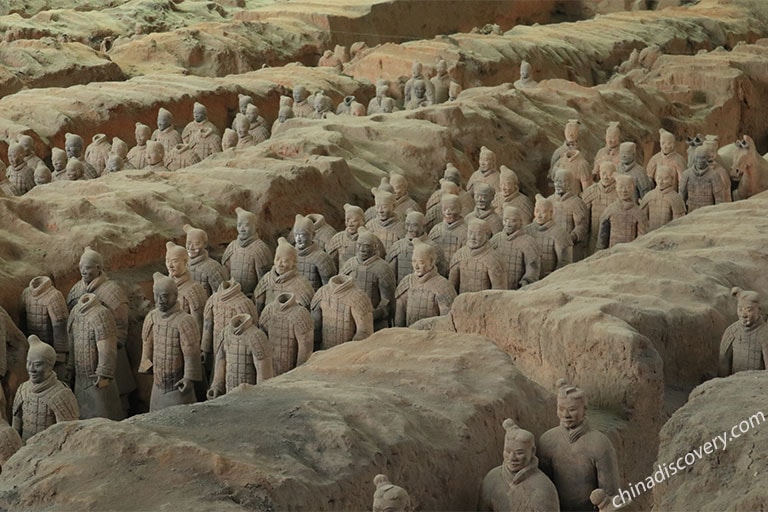 Pit 1, Largest One of All the Three
Pit 1, Largest One of All the Three
Though smaller than Pit 1, Pit 2 is called the essence of the three pits for it has more complex battle array and more kinds of warriors. The discovery of the Pit 2 revealed the mystery of ancient battle array. Discovered in 1976, Pit 2 houses over 1,300 terracotta warrior and horses, and covers an area of 6000m2 and is made of four units.
The first unit is in the eastern part, composed by kneeling and standing crossbowmen. The second unit is the chariot array in the southern part. The third unit is the central array, composed by chariot, infantry and cavalry. And the fourth unit is the cavalry array in the northern part. Organic combination of the four units forms an unassailable army array, highly efficient in attack and defense.
Only 520m2 large, 17.6m from east to west and 21.4m from south to north, Pit 3 is the smallest one. It has 72 terracotta warriors and horses in total. According to the arrangement in the pit, archaeologists believe that Pit 3 is the command center of Pit 1 and Pit 2. Also, Pit 3 is the only pit surviving fire attack in history, thus, the terracotta warriors reserved more colors when they were unearthed.
The Exhibition Hall has three display rooms to exhibit various articles from Qin Dynasty. The most famous one is the Bronze Chariot and Horses. In 1980, archaeologists discovered two sets of bronze chariots and horses from 20m west of the Mausoleum of the First Qin Emperor. Each chariot was equipped with four bronze horses, and they are the half size of the real imperial chariots for the Emperor Qinshihuang. Made of over 3,000 components, the shape and structure of the Bronze Chariots and Horses are almost the same with the real one. Over 2,000 years, the carriage wheels can still rotate, while the halter and the rein are still flexible, how amazing it is! The Bronze Chariots and Horses are the largest and most completed ancient carriage unearthed in history, such reputed as the Crown of the Bronze Works.
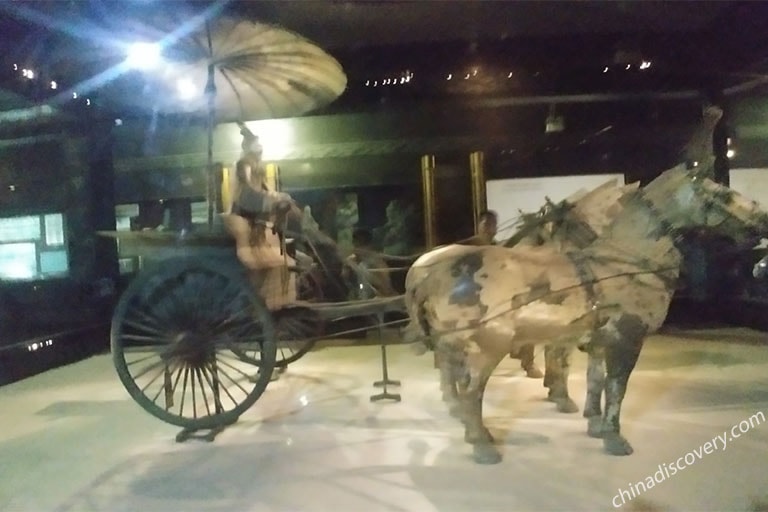 Bronze Chariot and Horses of over 2,000 Years
Bronze Chariot and Horses of over 2,000 Years
It’s said that no two terracotta warriors are alike. Facial expression, hair style, moustache style, costume and hand gesture are various from each other. Qin terracotta warriors were made using realistic style. So, after the unification of China, soldiers in Qin Army were from different areas and technics; besides, craftsmen were varied with different life experiences and skill, thus, no two terracotta warrior are the same.
Since most of the terracotta warriors are look white grey today, it’s hard to imagine that they were painted with different colors in the past. The original terracotta warriors were painted with skin color on the face and hand, and their costumes were also painted with various vivid colors. However, when they were unearthed, the terracotta warriors were oxidized and all colors just turned into white grey in few minutes. The good news is that after a decade’s efforts, with the help of Germany scientists, the color of the terracotta can be reserved now.
The average height of terracotta warriors is about 180cm; however, the average height of Qin people is about 170cm. Why is the difference? According to the archaeologist, after Emperor Qinshihuang unified China, it’s easy to choose tall and strong soldiers from all over the country. On the one hand, Qin was famous for its strong military force; of course the army would recruit taller and stronger ones as its warriors. On the other hand, Emperor Qinshihaung craved for greatness and success, and he preferred more magnificent and delicate works.
Tens of thousands of bronze weapons were unearthed with the discovery of the Terracotta Warriors and Horses. The bronze weapons were all actual combat weapons in Qin Dynasty. After being buried in the ground for over 2,000 years, no corrosion had happened to the weapons. The craftsmen at that time had conducted chemical treatment to the bronze weapons, thus formed a chromium oxidation layer to keep the weapon from corrosion. You will be surprised when knowing that the similar technology was invented by the US in the 50s of 20th century.
>> Terracotta Warriors Facts - 10 Questions about The Terracotta Army
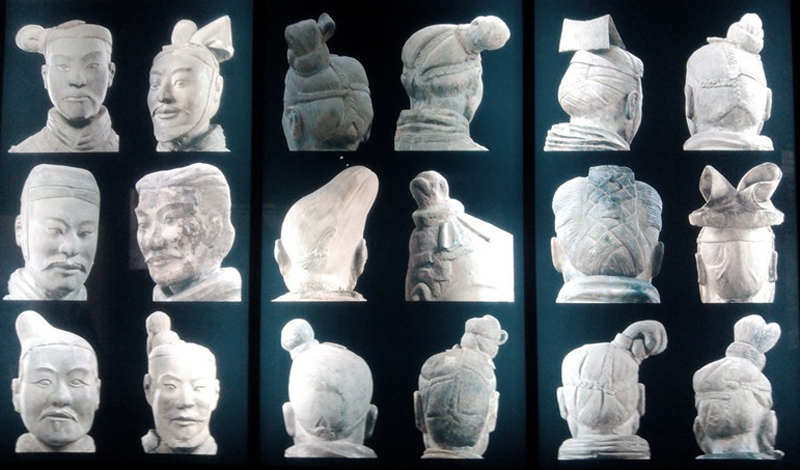 Different Faces of Terracotta Warriors
Different Faces of Terracotta Warriors
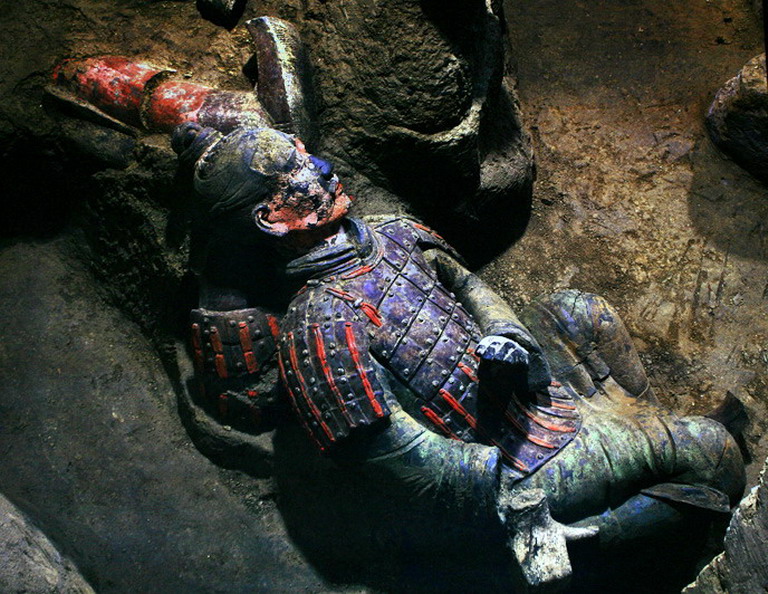 Colorful Terracotta Warriors
Colorful Terracotta Warriors
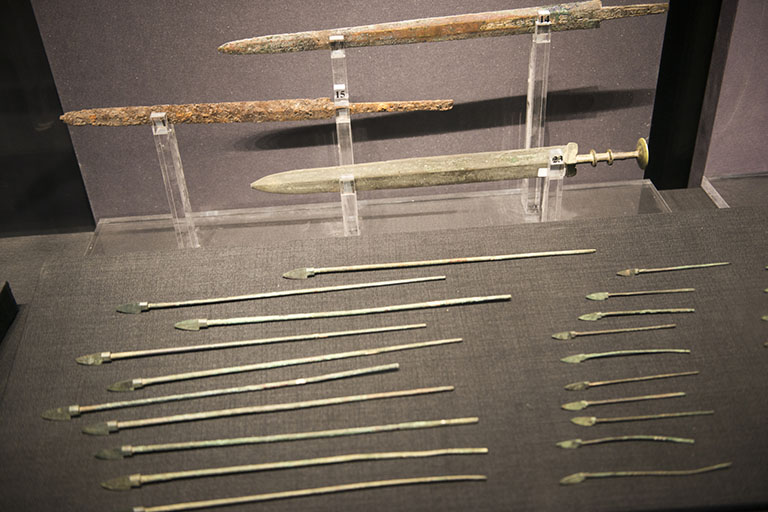 Bronze Swords and Arrows
Bronze Swords and Arrows
Qinshihuang (秦始皇 259 – 210BC), known as the first emperor in China, whose name was Ying Zheng (嬴政), came to the throne of Qin State when he was 13, then from 236 BC to 221 BC, Qin army defeated all other States and united China. From then, he established the first united centralized feudal state in Chinese history – Qin Dynasty (秦朝), and Ying Zheng was then called Qinshihuang or Qin Shi Huang (Qin: Qin Dynasty; Shi: first; Huang: emperor). Since then, the title emperor (huangdi, 皇帝) was continually used by the highest ruler of China for over two thousand years.
Since he became the king of Qin in 13 year old, Qinshihuang stated to build his mausoleum, and according to the historical records, Qinshihuang put over 700,000 workers (the figure is larger than any city of the world at that time) to the construction and the whole project lasted 37 years. The whole mausoleum imitated the layout of Xianyang, the capital city of Qin for the first Emperor wanted to continue his reign in the after world. Terracotta Warriors and Horses is an important part of the mausoleum, and most scholars believe that the Terracotta Army symbolizes the defensive army stationed outside the capital city.
Except for the highly skillful sculpture art, the importance of Terracotta Army also lies in its reflection of Qin’s military technology. The Terracotta Army stimulates the ancient battle array, forms a magnificent military scene, and reveals the true face of Qin army.
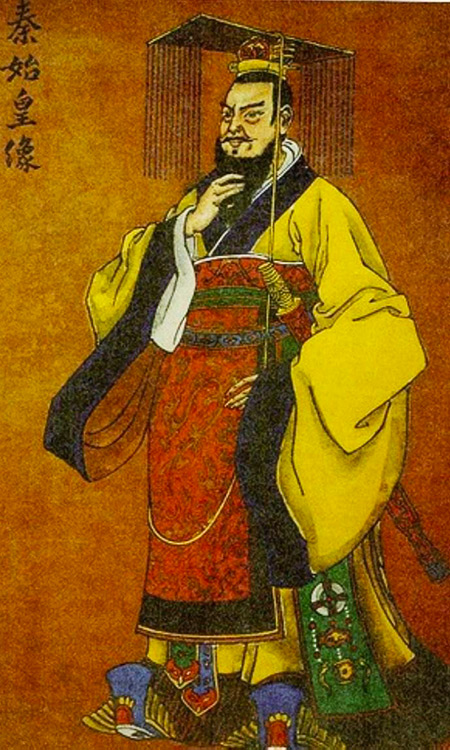 Emperor Qinshihuang, First Emperor in China
Emperor Qinshihuang, First Emperor in China
Tickets: ¥120 / person / time
Sightseeing bus: ¥5
Opening Hours:
March 16th – November 15th: 8:30-18:00 (no selling after 17:00)
November 16th – March 15th: 8:30-17:30 (no selling after 16:30)
There are three Tourist Service Centers, and they are located in the east of ticket hall, the south of the square before Pit 1, and the east of the landscape stone of Lishanyuan (丽山园). The service center can accept complaints, and provide medical assistance, consultant, wheelchair and stroller for free, and tourists can charge their mobile phone and take a rest at the service center.
There are free toilets in the museum. As for the specific location, please refer to the guide indicator.
The museum provides professional guide service in Chinese, English and Japanese, and tourist can make a reservation for the guide service of the expert in the museum. There are also non-scheduled free consulting services provided by volunteers.
To protect the Terracotta Warriors and Horses, please turn off the flash of your camera when you take photos.
The weather of Xi’an is very dry, drink more water and use some moisturizer to help your skin retain moisture. If you come in summer, use some sun block to protect your skin from the strong UV of Xi’an.
If you are keen on the terracotta warriors, you can buy some terracotta replicas outside of the museum. Many souvenir shops in Xi’an city center also sell terracotta replicas.
Xian has a lot of places to visit. Terracotta Warriors and Horses is definitely the No.1 must-see. After that, take a stroll or rent a bike on the Ancient City Wall, the largest and best-preserved ancient city wall in China, to enjoy panoramic views of modern Xi’an. Then try some local snacks at the bustling and lively Muslim Quarter. On the next day, you can go to visit Da Cien Temple and Giant Wild Goose Pagoda to feel the Buddhist culture, then get a deeper understanding of the past of this city in Shaanxi History Museum. If you are interested in mountain climbing, don’t miss the challenging Mount Huashan which is famous for lofty peaks and steep paths. If you have other ideas or questions about a Xian tour, please feel free to contact us. We are also specialized in customized tours according to your own requirements, interests, travelling budgets, etc.
- 2 Days Xian City Break
- 3 Days Classic Xian Tour
- 4 Days Xian Highlights Tour with Mount Huashan Hiking
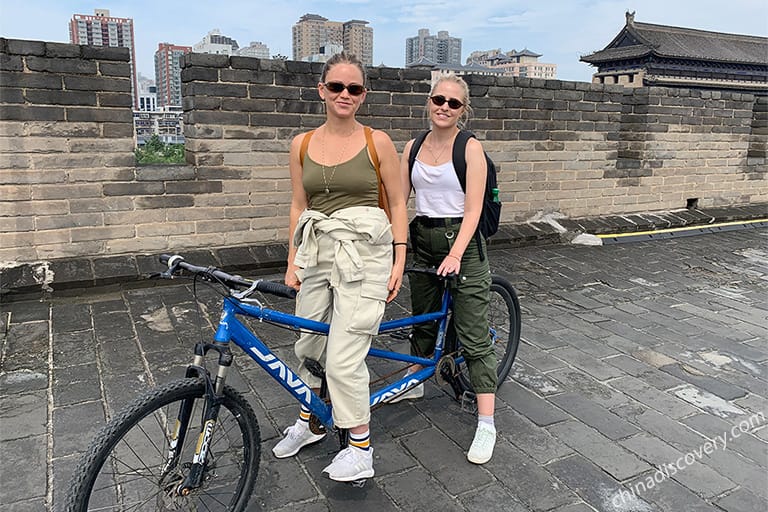 Biking on Xian Ancient City Wall
Biking on Xian Ancient City Wall
It’s always a truth to do some homework before visiting a great cultural spot, same to the Terracotta Army. During the short trip, knowing relevant introduction and travel tips helps you understand the heritage better and memorize more interesting details tour guide may communicate with you. Otherwise, the finally-realized dream tour might be end up in taking tourists photos, watching yellow clay figurines you still knows basically from online. Below are very useful articles we picked for you, hope you refresh a Terracotta Army tour and return with nice memories.
Top 3 Xian tours chosen by most customers to explore Xian in the best way. Check the detailed itinerary, or tailor your own trip now with us.
Start planning your tailor-made holiday to China by contacting one of our specialists. Once inquired, you’ll get a response within 0.5~23.5 hours.
Customize a Trip